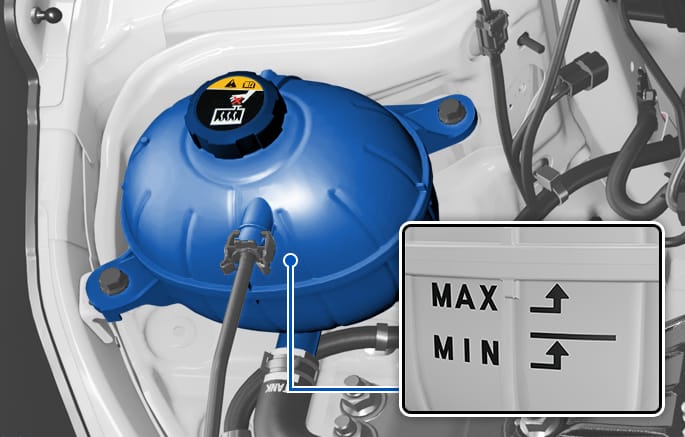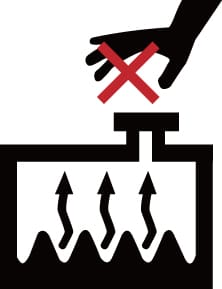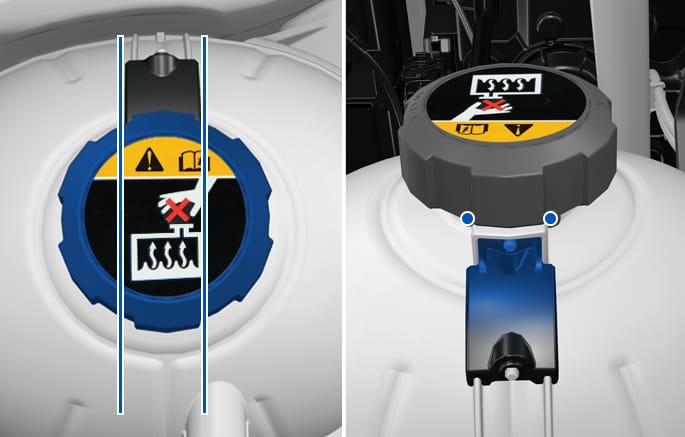Engine Coolant
The high pressure cooling system has a reservoir filled with year-round antifreeze coolant. Check the antifreeze protection and coolant level at least once a year, before the winter season or before traveling to a colder climate.

2C_EngineCoolant
Check the condition and connections of all cooling system hoses and heater hoses. Replace any swollen or deteriorated hoses.
The coolant level is influenced by the engine temperature. Before checking or refilling the coolant, turn off the engine and allow the engine to cool.
The coolant level should be filled between the MAX and the MIN marks on the side of the coolant reservoir when the engine is cool.
If the coolant level is low, add enough distilled (deionized) water mixed with antifreeze to bring the level to the MAX mark. If frequent additions are required, have your vehicle inspected by an authorized HYUNDAI dealer for a cooling system inspection.
-
Never remove the engine coolant reservoir cap, radiator cap, or drain plug while the engine and radiator are hot. Hot coolant and steam may blow out under pressure, causing serious injury.

-
Turn the vehicle off and wait until the engine cools down. Use extreme care when removing the engine coolant cap and radiator cap. Wrap a thick towel around it, and turn it counterclockwise slowly to the first stop. Step back while the pressure is released from the cooling system. When you are sure all the pressure has been released, press down on the cap, using a thick towel, and continue turning counterclockwise to remove it.
-
Make sure the coolant cap is properly closed after refilling coolant. Otherwise, the engine may be overheated while driving.
Check if the coolant cap label is straight in front and the tiny protrusions inside the coolant cap are securely interlocked.
Engine compartment front view
2C_CheckCoolantCapLocked
The coolant should be changed at the intervals specified in the maintenance schedule.
Recommended coolant
-
When adding coolant, use only deionized water, distilled water, or soft water for your vehicle and never mix hard water in the coolant filled at the factory.
-
An incorrect coolant mixture may result in severe malfunction or engine damage.
-
The engine in your vehicle has aluminum engine parts and must be protected by a phosphate-based ethylene glycol coolant to prevent corrosion and freezing.
-
Do not use alcohol or methanol coolant or mix them with the specified coolant.
-
Do not use a solution that contains more than 60 % antifreeze or less than 35 % antifreeze, which could reduce the effectiveness of the solution.
For mixing percentage, refer to the following table:
|
Ambient Temperature |
Mixture Percentage (volume) |
|
|
Antifreeze |
Water |
|
|
5 °F (-15 °C) |
35 |
65 |
|
-25 °C (-13 °F) |
40 |
60 |
|
-31 °F (-35 °C)*1 |
50 |
50 |
|
-49 °F (-45 °C) |
60 |
40 |
If in doubt about the mix ratio, a 50 % water and 50 % antifreeze mix is the easiest to mix together as it will be the same quantity of each. It is suitable to use for most temperature ranges of -31 °F (-35 °C) and higher.
Have the coolant changed by an authorized HYUNDAI dealer according to the maintenance schedule at the beginning of this chapter.
Do not use engine coolant or antifreeze in the washer fluid reservoir.
Engine coolant can severely obscure visibility when sprayed on the windshield and may cause loss of vehicle control resulting in an accident.
Engine coolant may also cause damage to paint and body trim.
To prevent damage to engine parts, put a thick towel around the engine coolant reservoir cap before refilling the coolant to prevent the coolant from overflowing into engine parts, such as the alternator.